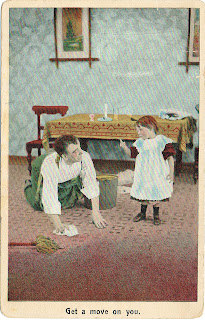This postcard shows the Parish Church in Croydon, England. Croydon Minster is the parish and civic church of the London Borough of Croydon. There are currently more than 35 churches in the borough, with Croydon Minster being the most prominent. It is Grade I listed. Six Archbishops of Canterbury are buried in the church: Edmund Grindal (d.1583), John Whitgift (d.1604), Gilbert Sheldon (d.1677), William Wake (d.1737), John Potter (d.1747), and Thomas Herring (d.1757).
The tower houses a ring of 12 bells cast by the Croydon firm of Gillett & Johnston
in 1936, replacing an earlier ring of eight. The eight original bells
were recast and hung with new fittings in a new frame with four
additional trebles. The new ring of 12 was dedicated by the Bishop of
Croydon on 12 December 1936 and the first peal on the new 12 was rung
for the coronation of King George VI and Queen Elizabeth in 1937. The tower and ringers are affiliated to the Surrey Association of Church Bell Ringers.
The card was sent on 6 February 1906 7:15 pm. It reads: 'Dear K, I shall be home tomorrow unless anything turns up. But I expect it will be late, I will see you on Thursday at any rate. Yours Bert'.

















































